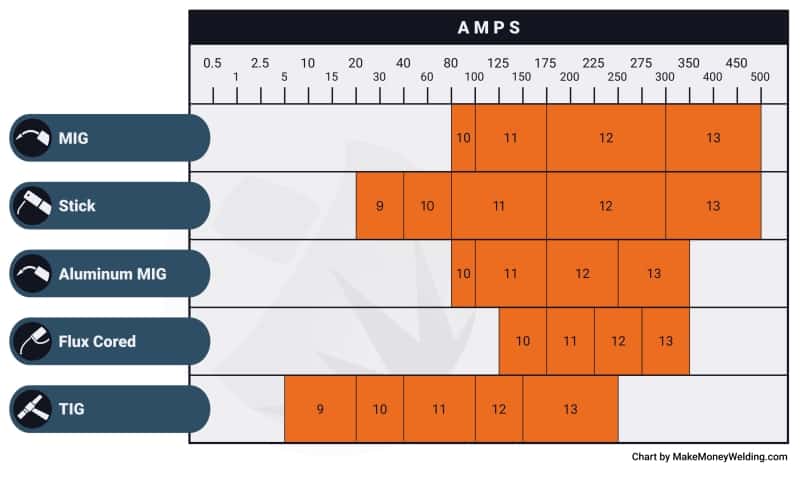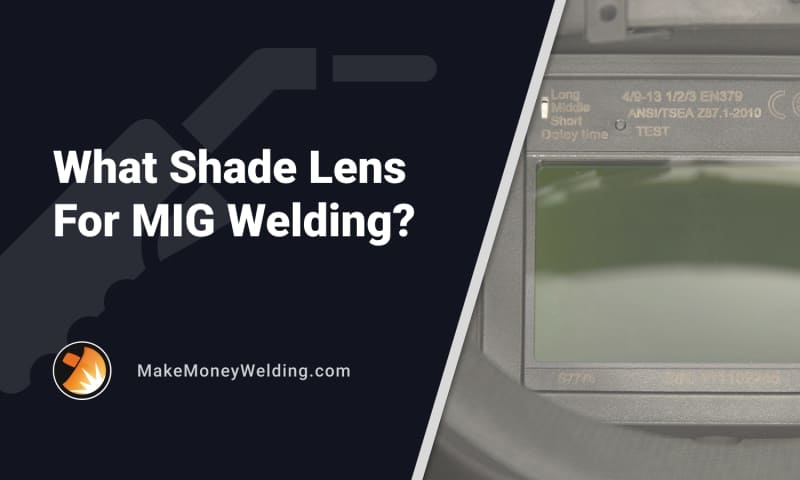When welding, it’s crucial to follow safety protocols and get the needed safety gear, including a welding helmet with adequate shade.
According to OSHA, the recommended minimum shade number for MIG welding above 60 amps is 10. However, it all boils down to your needs.
So, how do you choose the right shade for MIG welding?
Read on to learn more about welding shades and how to find the perfect ones for your MIG welding projects.
What is Shade? & Why is it Important?
The primary function of a welding shade is to provide protection for your eyes and allow you to see clearly, helping you create top-notch welds.
Shades are necessary because your eyes are prone to radiation, spatter, and slag – leading to easy burns. You must weld with shades on to avoid serious injury.
However, using a shade that’s too dark for welding could lead to eye strain because you’ll constantly have to strain your eyes in order to see the welding puddle clearly.
Although eye strain is not a serious condition, it’s still quite annoying and could cause discomfort. Because of that, you need to make sure you select a suitable shade lens for every welding project.
One of the biggest welding mistakes you can make is welding without shade.
If that happens, you could experience numerous eye problems and injuries, including the welder’s flash/arc eye.
Welder’s Flash/Arc Eye (Photokeratitis)
Both the welder’s eye (or arc eye) refer to the same eye condition — photokeratitis. This condition occurs when you expose your eyes to the bright welding light that contains UV rays. The UV rays damage your cornea, which ends up being extremely painful.
Some of the symptoms of this condition include:
- Redness in the eyes
- Pain
- Swelling
- Tearing
- Sensitivity
- Blurred vision
- Seeling light
- Headaches
- Temporary vision loss
As this condition could damage your vision, you should wear a helmet with adequate shade and prevent these issues from happening.
How to Pick the Correct Shade for MIG Welding
If you’re a new welder, choosing the correct shade for MIG welding might be tricky, especially if you don’t know what to look for.
While there are multiple factors that will help you choose the proper eye protection for your needs, the two factors that stand out are — amperage and shade number.
Read more about them below.
Amperage
Amperage measures the flow of electrical charge in a welding circuit. This setting also determines the brightness of a welding arc, which impacts the welding shade you end up choosing.
Simply put: the higher the amperage, the darker the shade you need.
When welding with high amperage, a dark shade is necessary to protect your eyes and minimize the effects of radiation.
So, if you are light-welding and using lower amperage, go for a lighter shade.
Shade Number
According to OSHA, many workers, including welders, are prone to light radiation because of the arcs and flames they frequently encounter in their workspace – which is why they need protection with the adequate shade number.
The eye protection gear needs to have filter lenses in multiple different shade numbers. The shade number of every lens represents the intensity of the radiation that can pass through it before reaching your eyes.
The lenses with darker filters (shades) have higher shade numbers, which lower the intensity of the radiation passing through the lens and getting to your eyes.
One of the best ways to find a suitable shade lens for your needs is to consider the eye protection safety requirements given by the American National Standards Institute (ANSI) and the German Institute for Standardization.
ANSI has a Z87.1 certification that provides details about eye protective gear and the lenses you need for protection from different hazards.
To precisely decide which shade would work, for your project determine your welding technique and amperage, then look at the chart to determine which shade works best.
For example, when MIG welding and using an amperage between 80–100, shade 10 might be the best choice; if your amperage is between 100–175, shade 11 would be more suitable.
Shade Number Selection Chart

Click here for full size image
When choosing your shade, you should consider the welding technique and amperage required to weld a particular metal.
MIG welding, for example, involves exposure to UV rays. So, you’ll need a dark shade – preferably between 10 and 13 – to protect your eyes.
The chart below will show you the best shade options depending on your welding technique and the amperage it requires.
Here’s another way to determine the shade you need by considering the amperage for your MIG welding project.
| Amperage | OSHA Protective Shade Number | ANSI & AWS Shade Number Recommendations |
|---|---|---|
| Below 60 | 7 | / |
| 60 – 160 | 10 | 11 |
| More than 160 – 250 | 10 | 12 |
| More than 250 – 500 | 10 | 14 |
This chart from OSHA offers details about the shade requirements for welding.
The OSHA requirements represent the minimum protection shade your lens needs, while the AWS and ANSI metrics show the shade lens number that provides the best protection for your eyes.
According to OSHA, as a rule of thumb, it’s better to start by using a shade too dark, slowly switching to a lighter shade that gives you a better view of the weld puddle without going below the minimum.
Other Variables to Consider
Fixed vs. Variable Shade Lens
Before getting your shade, you should consider whether you want a fixed or variable shade lens.
Helmets/masks with fixed shade lenses only work for one specific shade number, which is why they’re typically cheaper to get and maintain. These are mostly passive helmets, and you have to adjust them up and down to see the welding puddle.
Variable lens helmets tend to be more expensive, but they can adjust between multiple shade numbers depending on your welding technique and welded material.
Because they have front sensors that automatically switch between shades when the welding light hits the lens, many refer to variable lens helmets as auto-darkening helmets. These helmets are fast and darken almost instantly, preventing your eyes from burns and other conditions.
That said, if you only weld on one material and with one welding process, a fixed shade lens helmet will work for you. But, if you weld multiple materials and use different welding processes, it’s better to go for a variable shade lens.
Overall, a variable shade lens would be more suitable when speaking about MIG welding.
Arc Sensors
Auto-darkening helmets have arc sensors that allow them to sense the welding spark and therefore darken. Typically, basic auto-darkening helmets have around two sensors, while professional ones have around 3–4.
The position, sensitivity, and number of these sensors in a welding helmet are also crucial as they allow the helmet to react to the surrounding light when supposed to.
The more sensors, the better the helmet because a helmet with multiple arc sensors it’s less likely to fail you.
Reaction Time
The reaction time of your shade refers to the time needed for the lens to turn from a regular to a protective lens in contact with welding torch light.
The darkening occurs fast and protects your eyes from harmful radiation. If there’s a delay in the reaction time, your eyes could get injured, and you could suffer from an arc eye.
Professional helmets usually have a reaction time of around 1/20,000 seconds, while regular helmets need more time to react, typically around 1/3,600 seconds. The larger the fraction, the faster the reaction time of your lens.
13 is Not The Highest Shade
While most consider 13 the highest shade, there’s one shade higher; the shade 14.
Shade 14 is frequently hard to get hold of because it’s so dark that it filters out most of the light. This could prevent you from seeing while welding and would also cause you to strain your eyes.
Most of the time, people use these helmets if they have extremely damaged vision or sensitive eyes. However, they are not the most desirable shade for everyday use.
FAQs
Do you need a mask for MIG welding?
Yes. A mask is considered necessary welding equipment to protect your eyes and face from harmful UV radiation and possible injuries.
You can select the right shade depending on the amperage for your MIG project; the shade lens on your wedding mask should be between 10 and 13. Because of that, variable masks and helmets might be a better choice than fixed ones.
What is a good welding mask for a hobbyist doing occasional MIG welding at home?
If you’re a hobbyist and you do occasional MIG welding at home, there’s no need to spend money on professional helmets. A regular, passive helmet would be the best option as they are cheap and easy to use.
Of course, if you plan on welding more in the future and want to try out different materials, it might be good to spend the extra money and get an auto-darkening professional helmet.
Is Shade 5 good enough for welding?
If you’re light welding (gas welding/oxy-fuel welding and cutting) shade 5 will be good enough for you. However, such shade lenses are unsuitable for MIG and other welding processes like TIG, Flux-cored, and Stick welding.
What is the minimum shade for welding?
The minimum shade for a welding lens is 3 (before the arc light), but the minimum shade for your welding process will vary depending on the amperage and your welding technique.
The industry standards for welding shades range from 5–13, with their minimum shade being between 3 and 4 before they darken. There’s also a darker shade with the number 14, although it’s not that common as it’s typically too dark.
Wrapping it Up
Having the proper shade when welding is essential to protect your eyes from serious injuries while allowing you to create quality welds. Before you decide on a helmet, consider all the factors from our article, especially the amperage and shade number.
MIG welding will typically require you to have shade between 10–13, but you should adjust it for every project accordingly.
As a rule of thumb, always start with a shade too dark to see the weld zone, and adjust it lighter if needed, without going below the minimum shade recommendation. And as always, follow the recommended safety guidelines.


